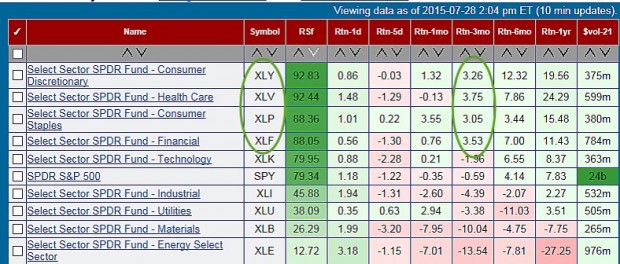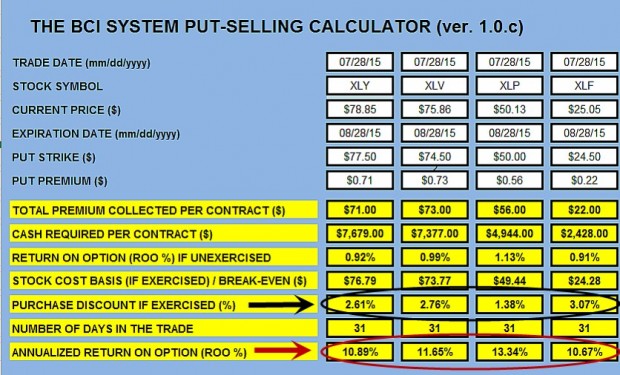Micron surges after one of the biggest beats in U.S. semis history
Selling out-of-the-money puts and using top-performing Select Sector SPDRs can be combined to design an extremely defensive option-selling strategy in a volatile market environment like we are currently experiencing. Using Inverse Exchange-traded Funds is another approach. In this article, we will discuss the former strategy. When we sell an out-of-the-money cash-secured put we are agreeing to purchase that security at a price lower than its current market value. In a bear or volatile market environment this can be a sensible approach to generating monthly income while still emphasizing capital preservation. Our breakeven becomes the strike price minus the put premium. If a stock was selling for $52.00 and we sold the $50.00 out-of-the-money put for $2.00, our breakeven would be $48.00.
The Select Sector SPDRs are exchange-traded funds that divide the S&P 500 into nine sector index funds. We can choose the current top-performing sectors and then sell out-of-the-money puts on those ETFs that are currently in favor. Since ETFs in general, and especially those associated with the S&P 500, have lower option premiums, we must lower our goal expectations in exchange for the protective nature of this strategy. 10%-12% annually would be a reasonable objective. The screenshot below depicts the top-performers as of 7/28/2015, a screenshot I took prior to the current market decline:

Note the following 3-month performances:
- SPDR S&P 500 (NYSE:SPY)- (-)0.59%
- Consumer Discretionary Select Sector SPDR (NYSE:XLY)- + 3.26%
- Health Care Select Sector SPDR (NYSE:XLV)- + 3.75%
- Consumer Staples Select Sector SPDR (NYSE:XLP)- + 3.05%
- Financial Select Sector SPDR (NYSE:XLF)- + 3.53%
31-Day Returns
We first access an options chain and then feed the information into the BCI Put Calculator:

Note the following % discount if exercised (black arrow) and annualized returns (red arrow):
- XLY- 2.61% (10.89%)
- XLV- 2.76% (11.65%)
- XLP- 1.38% (13.34%)
- XLF- 3.07% (10.67%)
Steps After Exercise or Non-Exercise
If the option expires worthless (share price remains above the strike price), we continue to write out-of-the-money puts looking to generate 1% per month. If the option is exercised and we buy the underlying ETF(s) at the “discounted” price, we can then either write an in-the-money covered call or sell the security and replace it with a better-performer.
Discussion
Option-selling strategies can be crafted to accommodate market conditions and personal risk-tolerance. In bear or volatile market conditions combing out-of-the-money cash-secured puts and Select Sector SPDRs is one way to develop a defensive option-selling blueprint.
Department of Labor proposed Laws Relating to Options in IRA Accounts
Some of our members have become aware of and are concerned regarding laws recently proposed by the Department of Labor regarding the use of options in IRA accounts. Many of our members currently use options in these accounts and have expressed concern to me.
I have contacted the CBOE, contacts I have at FINRA and a few Financial Advisors familiar with the situation and here is what I can report at this time:
- DOL’s proposal wouldn’t preclude covered call writing in self-directed IRAs
- The proposal essentially would require those advising holders of 401(k) plan accounts, individual retirement accounts (IRAs) and other self-directed retirement plan accounts to act as fiduciaries
- The fiduciary standard is the applicable standard for Investment Advisory-based accounts. For brokerage accounts, the standard is not as stringent
- The impact of the proposal would be on the brokerage side
- The rule would not prohibit covered call writing in self-directed IRAs, but may prohibit Advisors from charging for covered call writing-based recommendations
- The rule would permit brokerage account Advisors to charge for recommendations in connection with the purchase or sale of an “asset” for an IRA. Regarding the definition of an “asset,” the proposal, in its current state, specifically excludes options-based recommendations, meaning an advisor would not be able to charge for recommending writing calls
- It appears more about precluding charges for options based advice vis a vis IRAs, and not about precluding the strategy itself
- The OCC formally commented on the DOL proposal. I think you will find the OCC’s submission useful. You can find it here.
The information I have received thus far indicates that we will still be able to write calls in our IRAs. The proposed laws seem geared to assuring the advisers adhere to the fiduciary responsibilities they are legally bound to. Any additional insurances or costs to advisers and brokers may, however, eventually be passed onto us. I will update our members as I learn more on this topic.
Market Tone
Market volatility continued as investors remained concerned about China’s slowing economy and a possible interest rate increase by the Fed in September. Stocks moved considerably from day-to-day and mostly on the downside although volume was light due to the upcoming holiday weekend. A positive jobs report increased concerns about a rate hike. This week’s reports:
- The US economy added 173,000 jobs in August, fewer than expected, but initial estimates for that month tend to be revised up significantly.
- The unemployment rate fell to 5.1%, the lowest in more than seven years.
- Average hourly earnings increased 8 cents and average weekly hours worked rose to 34.6.
- The broader U6 measure of joblessness, including discouraged workers and those working part-time for economic reasons, fell to 10.3%, the lowest since June 2008.
- The US trade deficit fell to a five-month low in July, declining 7.4% to $41.9 billion from $45.2 billion in June.
- US non-farm productivity rose 3.3% in the second quarter, its strongest pace since the fourth quarter of 2013, after shrinking 1.1% in the first quarter.
- The longer-term trend in productivity remains weak, increasing just 0.7% from a year ago.
- The US services sector growth improved from 55.7 in July to 56.1 in August.
- The manufacturing PMI fell from 53.8 in July to 53.0 in August.
- The Institute for Supply Management’s index fell from 52.7 in July to 51.1 in August.
- Initial jobless claims increased 12,000 to 282,000 for the week ended 29 August.
- Continuing claims fell 9,000 to 2.26 million for the week ending August 22nd.
For the week, the S&P 500 rose 0.91% for a year to date return of (-) 3.40%.
Summary
IBD: Market in correction.
GMI: 0/6- Sell signal since market close of August 24, 2015.
BCI: This site remains bullish on the US economy but concerned about market reaction to events in China as well as the Fed watch. I am also watching the VIX, usually inversely related to the market direction, currently at 30, a bit high for my taste. At this time, I am retaining all shares currently in my portfolios but not purchasing new ones or writing calls until a bottom is identified.
